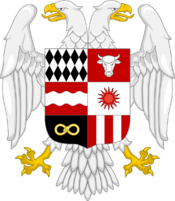Kingdom of Amathia: Difference between revisions
No edit summary |
No edit summary |
||
| Line 59: | Line 59: | ||
|s5 = | |s5 = | ||
|flag_s5 = | |flag_s5 = | ||
|image_flag = | |image_flag = Flag of Belarus (government in exile, 1919-1925).svg | ||
|flag_alt = Royal Flag of Amathia | |flag_alt = Royal Flag of Amathia | ||
|image_flag2 = AmathiaF.png | |image_flag2 = AmathiaF.png | ||
Revision as of 01:32, 10 February 2020
This article is incomplete because it is pending further input from participants, or it is a work-in-progress by one author. Please comment on this article's talk page to share your input, comments and questions. Note: To contribute to this article, you may need to seek help from the author(s) of this page. |
Kingdom of Amathia Ⱃⰵⰳⰰⱅⱆⰾ Ⰰⰿⰰⱚⰹⰵⰹ Regatul Amathiei | |||||||||||
|---|---|---|---|---|---|---|---|---|---|---|---|
| 1729–1940 | |||||||||||
Above: Flag of Amathia from 1729 to 1924, and 1934 to 1940
Below: Flag of Amurgist Amathia from 1924 to 1934 | |||||||||||
| Motto: "Ⱇⰹⰰⱅ ⰹⱆⱄⱅⰹⱅⰹⰰ ⰵⱅ ⱂⰵⱃⰵⰰⱅ ⰿⱆⱀⰴⱆⱄ!" ""Fiat iustitia, et pereat mundus!"" 'Let justice be done,though the world perish!' | |||||||||||
| Anthem: Long live the King! | |||||||||||
| Capital | Arciluco | ||||||||||
| Religion | Episemialism | ||||||||||
| Demonym(s) | Amathian | ||||||||||
| Government | Absolute monarchy (1729-1840) Constitutional monarchy (1840-1925) Amurgist dictatorship (1925-1935) Military dictatorship (1935-1940) | ||||||||||
| Legislature | Senate | ||||||||||
| Royal Council | |||||||||||
| Popular Assembly | |||||||||||
| History | |||||||||||
• Established | 10th May 1729 | ||||||||||
• Disestablished | 23rd August 1940 | ||||||||||
| Currency | Libra | ||||||||||
| |||||||||||
| |||||||||||
The Kingdom of Amathia (Amathian: Ⱃⰵⰳⰰⱅⱆⰾ Ⰰⰿⰰⱚⰹⰵⰹ, tr. Regatul Amathiei), was a state in Southeastern Euclea from 1729 to 1940. The Kingdom was founded after the collapse of the Union of Three Nations, with the abolishing of the previous elective monarchy and the creation of an Amathian state under the Gaullican House of Telois-Tresia. The new state abolished many of the freedoms that the Brotherly Union had previously established, but such measures were effective in stabilizing the region and ending the religious conflicts that had plagued Amathia in the past. The new foreign dynasty on the throne also took great leaps in modernizing the previously stagnating realm, and reorganizing its administration and military. By the end of the 18th century, Amathia was striving to be a regional power of its own, but it was caught between the conflict interests of Narozalica, Gaullica, and Etruria, and its foreign policy was weakened by internal dissent between the mostly pro-Narozalican population and the pro-Gaullican elites. The country's failure to truly establish itself as a regional influence, combined with a failed colonial adventure and tensions with Narozalica during the Partition of Minilov led to the Amathian monarchy firmly orienting itself towards Gaullica, remaining firmly aligned with it for the rest of its existence.
The Constitutional Revolution of 1840 introduced true democracy to the new state, but it was in fact less of a revolution and more of a series of reforms. The introduction of elections and the creation of a legislative body in the Senate were important steps, but were also cracks in the stability that the kingdom had otherwise experienced - the regional allegiances and religious differences in the country negatively affecting its politics, while dissatisfaction over perceived territorial injustices on Amathia's borders with Etruria and Narozalica slowly grew.
The Great Collapse of 1913 and the chaos that followed undermined public trust in the institutions of democracy, with multiple authoritarian parties rising to fill the void. The Senate proved to be unable to guard Amathia's democracy, with the authoritarian tradtionalist right-wing Sentinels of the Twilight coming to power, popularly known as Amurgists, after their native name. The Amurgists began a program of aggressive militarization and firmly positioned the country as an important member of Functionalist Gaullica's Entente. As such, Amathia was dragged into the Great War, which would ultimately prove to be disastrous for the state. Despite early victories, Amathia's frontlines turned into bloody stalemates, the and the specter of defeat led to a military coup against the Amurgists, who were becoming more and more fanatical and erratic, a coup supported by Gaullica. The military succeeded in taking control of Arciluco, but the young King refused to acknowledge the Functionalist military junta, while the advancing Narozalican armies declared their support for the Revolutionary Equalist Front, the dragging the country into a short but extremely bloody civil conflict.
This Amathian Civil War brought with it the end of the monarchy, the execution of most the royal family, the miraculous survival and exile of the King, and the declaration of the Amathian Equalist Republic, a new regime that would pursue closer relations with Narozalica and Swetania, and that would rule over the country for the next three decades.


